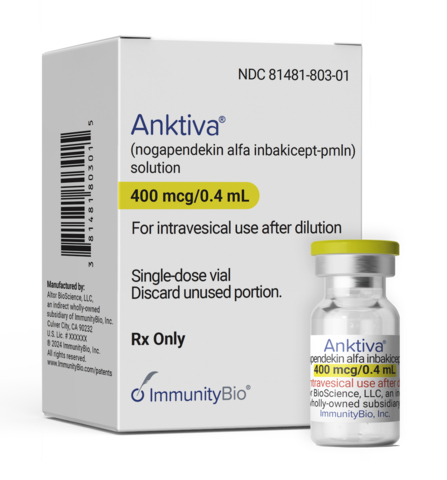Ferring Pharmaceuticals announced that the US Food and Drug Administration (FDA) approved Adstiladrin (nadofaragene firadenovec-vncg) for the treatment of adult patients with high-risk Bacillus Calmette-Guérin (BCG)-unresponsive non-muscle-invasive bladder cancer (NMIBC) with carcinoma in situ (CIS) with or without papillary tumors.
Adstiladrin is an adenoviral vector-based gene therapy that is non-replicating, so it cannot multiply in human cells.
Bladder cancer is the sixth most common cancer in the US, and around 75 percent of most newly diagnosed bladder cancers are NMIBC, a type of cancer that has grown through the lining of the bladder and has not invaded the muscle layer yet.
Treatment of patients with high-risk NMIBC, including patients with CIS (where cancer cells are detected in the place where they first formed and did not spread to nearby tissue), frequently involves removing the tumor and BCG treatment administered to the bladder.
BCG is a type of intravesical immunotherapy, and it is the fist-line standard of care for patients with high-grade NMIBC. However, more than 50 percent of patients who had an initial treatment with BCG will go through disease recurrence and progression within one year, with many of these patients developing disease that is unresponsive to BCG.
“Patients with BCG-unresponsive NMIBC have historically had limited treatment options other than bladder removal surgery,” said Steven A. Boorjian, MD, Carl Rosen Professor and Chair of the Department of Urology at Mayo Clinic, and lead investigator on the recent clinical trial of Adstiladrin, in the company’s press release. “The approval of Adstiladrin is therefore a significant advance in the current treatment landscape and provides a novel treatment option for patients.”
According to Ferring, Adstiladrin is expected to be commercially available in the US in the second half of 2023. The pharma company will expand its manufacturing capacity for commercial scale vector production for oncology treatment.
XTALKS WEBINAR: Importance of Early Integrated Evidence Strategy for Cell & Gene Therapies
Live and On-Demand: Wednesday, January 18, 2023, at 1pm EST (10am PST)
Register for this free webinar to find out through case studies and panel discussion, the value of defining an Integrated Evidence Strategy early on in cell and gene therapy development.
How Does the Gene Therapy Adstiladrin Work?
Adstiladrin is administered directly into the bladder using a catheter once every three months. The adenovirus vector enters the cells of the bladder wall and releases the gene interferon alfa-2b. Then, the cells translate the DNA sequence of the gene and secrete high amounts of the protein interferon alfa-2b. This protein is naturally occurring in the human body and the body uses it to fight cancer.
Therefore, Adstiladrin is a new approach to gene therapy as it enters a patient’s bladder wall cells to enhance their body’s natural defenses to combat cancer.
The Clinical Trial that Led to the Approval
The safety and efficacy of Adstiladrin was evaluated in a multicenter Phase III trial that involved 157 patients with high-risk BCG-unresponsive NMIBC. Out of these patients, 98 had BCG-unresponsive CIS with or without papillary tumors and could be evaluated for response. The patients were administered Adstiladrin directly into the bladder by instillation once every three months for up to 12 months, or until recurrent high-grade NMIBC or unacceptable toxicity to therapy.
More than half (51 percent) of the 98 patients with CIS with or without concomitant high-grade Ta or T1 bladder cancer achieved a complete response (the disappearance of all signs of cancer based on cystoscopy, tissue biopsy and urine). The median duration of response was 9.7 months.
Of the patients who had a complete response, 46 percent (n=23 of 50) were free of high-grade recurrence at 12 months.
In the study, the most common adverse events in order of decreasing frequency were instillation site discharge (33 percent), fatigue (24 percent), bladder spasm (20 percent), micturition urgency (19 percent) and hematuria (meaning blood in the urine; 17 percent). The discontinuation rate attributed to adverse events was 1.9 percent.
Immunosuppressed or immune-deficient people should not come into contact with Adstiladrin.
Patients in the study are continuing to be monitored for a total of five years.
“The approval of Adstiladrin showcases the power of private industry-academia partnerships in bringing novel treatments to market,” said Colin Dinney, MD, Chairman, Department of Urology, Division of Surgery, University of Texas MD Anderson Cancer Center, in the company’s press release.
“The Society of Urologic Oncology Clinical Trials Consortium (SUO-CTC) defined the clinical trial design required to address this patient population and has been a proud collaborator in the research of Adstiladrin, and we are delighted that such a transformative treatment is now approved by the FDA,” added Dr. Dinney.












Join or login to leave a comment
JOIN LOGIN